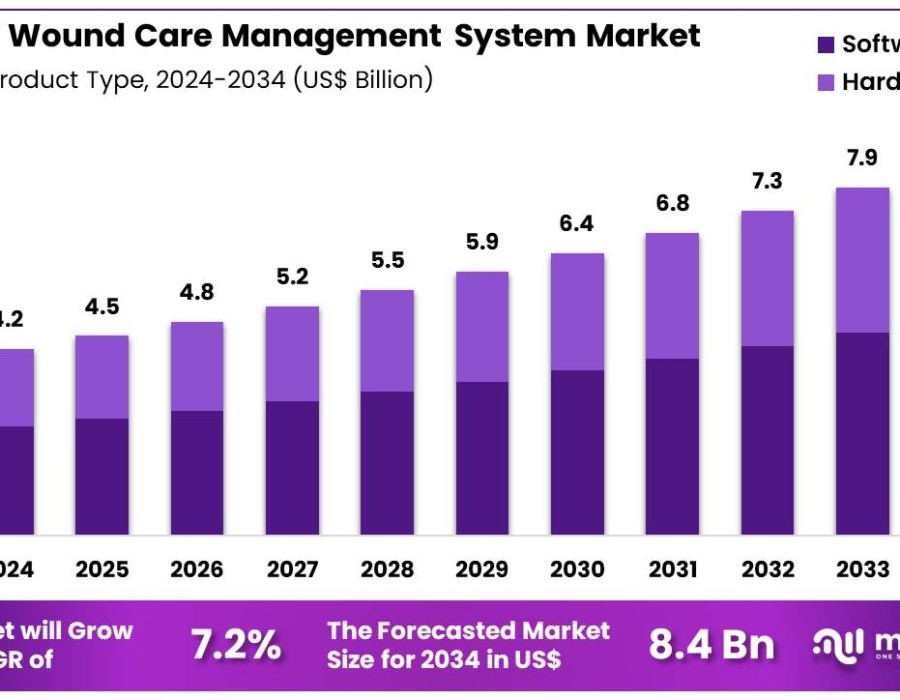The Global Digital Wound Care Management System Market is expected to grow from US$ 4.2 billion in 2024 to US$ 8.4 billion by 2034, at a CAGR of 7.2%. North America leads with 34.6% market share due to high healthcare spending and early telehealth adoption. However, emerging markets are rapidly advancing with better digital infrastructure. Key drivers include the rising global prevalence of chronic conditions like diabetes, where digital tools help monitor and manage slow-healing wounds in real time, reducing complications and hospital readmissions. The aging population also fuels demand, as digital wound apps enable home-based monitoring and quick specialist input. The pandemic accelerated telehealth adoption, and now remote wound care is embedded in standard recovery plans. Growing consumer comfort with digital tools, combined with AI-powered wound analysis and supportive reimbursement policies, is making digital wound management more accessible and financially viable across hospitals, clinics, and home-care settings.
![]()
Key Takeaways
- In 2024, the digital wound care management system market generated US$ 4.2 billion, projected to reach US$ 8.4 billion by 2034.
- The market is growing at a steady CAGR of 7.2% from 2025 to 2034, indicating strong long-term demand and adoption.
- The product type category is split into hardware and software, with software leading in 2023 by capturing a 58.4% market share.
- When it comes to application, chronic wounds dominated the market in 2023, holding a significant 64.2% share over acute wounds.
- North America emerged as the market leader in 2023, accounting for 34.6% of the total global digital wound care system revenue.
Emerging Trends
- AI-Powered Wound Assessment: Artificial intelligence (AI) is being used in mobile apps and devices to assess wounds faster and more accurately. These tools help healthcare workers measure wound size, depth, and healing progress in real time, reducing human error and saving time.
- Telemedicine Integration: Digital wound care platforms are being integrated with telehealth services. Patients can now receive virtual consultations, send images of their wounds securely, and get advice without traveling to a clinic or hospital. This trend is especially helpful in rural areas and during emergencies.
- Smart Dressings and Sensor Technology: There is growing interest in smart bandages that can track wound conditions like moisture levels and temperature. Some even have sensors to monitor healing progress or deliver electrical stimulation to speed up tissue repair.
- Cloud-Based Systems and 5G Connectivity: Wound care systems are increasingly cloud-based, meaning all data is stored online and can be accessed by doctors, nurses, and specialists from different locations. With the help of 5G networks, image sharing and patient monitoring are becoming faster and more seamless.
- Personalized Treatment Plans: Digital tools are now capable of creating tailored wound care plans. These are based on patient history, wound type, and healing progress, helping caregivers make better decisions and improve patient outcomes.
Conclusion
The digital wound care management system is quickly becoming an essential part of modern healthcare. As more hospitals, clinics, and caregivers use these technologies, patient care is becoming faster, safer, and more personalized. Digital tools help track healing, reduce complications, and make it easier for patients to receive care from home. With strong support from healthcare systems and growing trust from users, this market is set to keep growing. New advances like smart sensors, AI, and remote monitoring are shaping the future of wound care. As demand increases, digital solutions will continue to improve outcomes and reduce the burden on healthcare providers across different care settings.





Comments